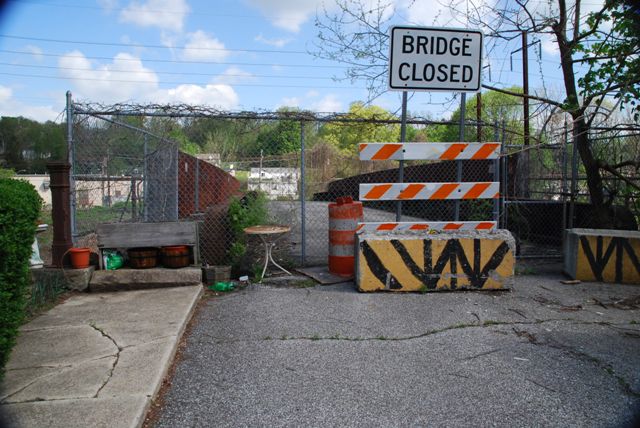We Recommend:
Bach Steel - Experts at historic truss bridge restoration.
BridgeHunter.com Phase 1 is released to the public! - Visit Now
West Bridge Street Bridge

Primary Photographer(s): Elaine Deutsch
Bridge Documented: April 28, 2011
West Bridge Street Over Railroad (Amtrak and Norfolk Southern)
Parkesburg: Chester County, Pennsylvania: United States
1954
46.0 Feet (14 Meters)
172.0 Feet (52.4 Meters)
19 Feet (5.79 Meters)
4 Main Span(s)
15741003100000

View Information About HSR Ratings
Bridge Documentation
View Archived National Bridge Inventory Report - Has Additional Details and Evaluation
This bridge is one of two highway plate girder overpasses in Parkesburg that cross over the historic Pennsylvania Railroad. They are noteworthy as increasingly rare examples of a highway over railroad plate girder bridge. Railroad over highway plate girder bridges are far more common. They are also considered eligible for the National Register of Historic Places due to their association with the Pennsylvania Railroad.
The two bridges in have been closed to traffic. These bridges, if they were to be rehabilitated and restored to their original appearance would be attractive historic bridges. They retain original ornate sidewalk railing posts, a hint at their former beauty. The riveted girders offer a level of detail and complexity not found on modern bridge beams. However, the addition of modern barriers including cyclone fencing and sheet metal guards near the areas that overhead electric cables that pass under the bridge greatly detract from the aesthetic qualities of the bridges. There are better ways to provide for safety while also not making the bridge look like part of a maximum security prison.
Information and Findings From Pennsylvania's Historic Bridge InventoryDiscussion of Bridge The 4-span, 172'-long, steel thru girder bridge has built-up girders, rolled floorbeams and stringers, and a timber deck. It is supported on ashlar abutments and built-up steel bents with crossbracing and stone pedestals. Sidewalks are cantilevered from both elevations. The bridge, a representative and complete period example of its type and design, is historically significant in association with the Philadelphia-Harrisburg division of the Pennsylvania RR Main Line, one of the historically most important and heavily engineered railroad right-of-ways in the state. Due to the volume of traffic, an important engineering consideration in the development of the line were efforts, especially in the early 20th century, to eliminate hazardous and delay-causing at-grade crossings with local streets and highways. The effort was made imperative when this section of the line was electrified in 1936-38. The Pennsylvania RR considered grade-crossing eliminations and overhead bridges, such as this 1903 thru girder bridge, an essential part of railroad operations on the Philadelphia-Harrisburg division of the Main Line. It is one of two nearly identical bridges in Parkesburg (the other is 15 7410 0300 0000). Discussion of Surrounding Area The bridge is closed to traffic. It carries a 2 lane road and 2 sidewalks over 2 electrified tracks of Amtrak and 1 non-electrified track of Conrail on the west side of Parkesburg. The line is the former Pennsylvania RR Main Line. The Main Line between Harrisburg and Philadelphia has been determined eligible by PHMC (DOE 9/14/93), based on its significance as a major trunk route between the eastern seaboard and Chicago. The line was electrified in 1936-38 as part of the PRR's electrification project, a major railroad engineering achievement of the 20th century. The setting is an undistinguished mix of late- 19th to late-20th-century residential and commercial development. Bridge Considered Historic By Survey: Yes |
![]()
Photo Galleries and Videos: West Bridge Street Bridge
Bridge Photo-Documentation
Original / Full Size PhotosA collection of overview and detail photos. This gallery offers photos in the highest available resolution and file size in a touch-friendly popup viewer.
Alternatively, Browse Without Using Viewer
![]()
Bridge Photo-Documentation
Mobile Optimized PhotosA collection of overview and detail photos. This gallery features data-friendly, fast-loading photos in a touch-friendly popup viewer.
Alternatively, Browse Without Using Viewer
![]()
Maps and Links: West Bridge Street Bridge
Coordinates (Latitude, Longitude):
Search For Additional Bridge Listings:
Bridgehunter.com: View listed bridges within 0.5 miles (0.8 kilometers) of this bridge.
Bridgehunter.com: View listed bridges within 10 miles (16 kilometers) of this bridge.
Additional Maps:
Google Streetview (If Available)
GeoHack (Additional Links and Coordinates)
Apple Maps (Via DuckDuckGo Search)
Apple Maps (Apple devices only)
Android: Open Location In Your Map or GPS App
Flickr Gallery (Find Nearby Photos)
Wikimedia Commons (Find Nearby Photos)
Directions Via Sygic For Android
Directions Via Sygic For iOS and Android Dolphin Browser
USGS National Map (United States Only)
Historical USGS Topo Maps (United States Only)
Historic Aerials (United States Only)
CalTopo Maps (United States Only)

